A Life Cycle Assessment (LCA) is an analysis of the impact one object has on the world around it. But who benefits from it? How does it work exactly? In this guide, you get an in-depth, non-technical overview of:
- What a Life Cycle Assessment really is,
- The different approaches to it,
- How it works in practice,
- And who can benefit from it.
Not wanting to read? We made a video as well! Watch it online.
Read all our LCA content in our LCA Hub!
What is a Life Cycle Assessment (LCA)?
What environmental impact does one object have on the world?
You probably asked yourself that question many times (sometimes without even knowing it). For example in the supermarket:
“How environmentally friendly were the products I just bought? Should I have bought the tomatoes from The Netherlands or from Spain?“
This, in a nutshell, is the question that a Life Cycle Assessment tries to answer. An LCA measures the environmental impact of a product through every phase of its life – from production to waste (or recycling, etc.).
But LCA isn’t simple – there are countless factors involved:
- Which raw materials were involved in the production process, and where do they come from? What about soil, seeds, and fertilizer?
- How do my goods get produced? What about heating, water, and ventilation?
- How did the goods get transported? Via truck, rail, or airplane?
A clear framework for measuring environmental impact
With all these factors – it gets confusing quickly. This is why the Life Cycle Assessment provides a framework for measuring the environmental impact of, for example, a product.
The goal of an LCA is to not only create data but also to facilitate decisions. That’s why it is always designed with a specific goal in mind. For example, to make a product more sustainable.
In this guide, we go through the concept of a Life Cycle Assessment step-by-step. The structure:
- Who needs an LCA? And why? Why we should conduct an LCA in the first place. Who is it relevant for? Who can benefit from it?
- The product Lifecycle. What are the different phases in a product’s lifecycle?
- The 4 Phases of a Life Cycle Assessment.
- LCA Standards and the legal situation – a quick overview
- LCA: Criticism
- LCA Tools you can use
1. Who needs an LCA? And why?
Before we dive into how a Life Cycle Assessment works, let’s break down who needs it in the first place.
Sustainability – Relevant For Everybody?
If you think about who might be interested in knowing more about the impact of your company, you could probably name everybody.
For example, HR managers might argue that potential candidates find it interesting to know more about the environmental footprint of their future employer.
But LCA is a very specific analysis. It provides the groundwork for any sustainability or CSR strategy within a company. That’s because you can only make decisions on things you’ve actually measured before.
According to our data, the following 4 departments in your company can take action based on an LCA right away.
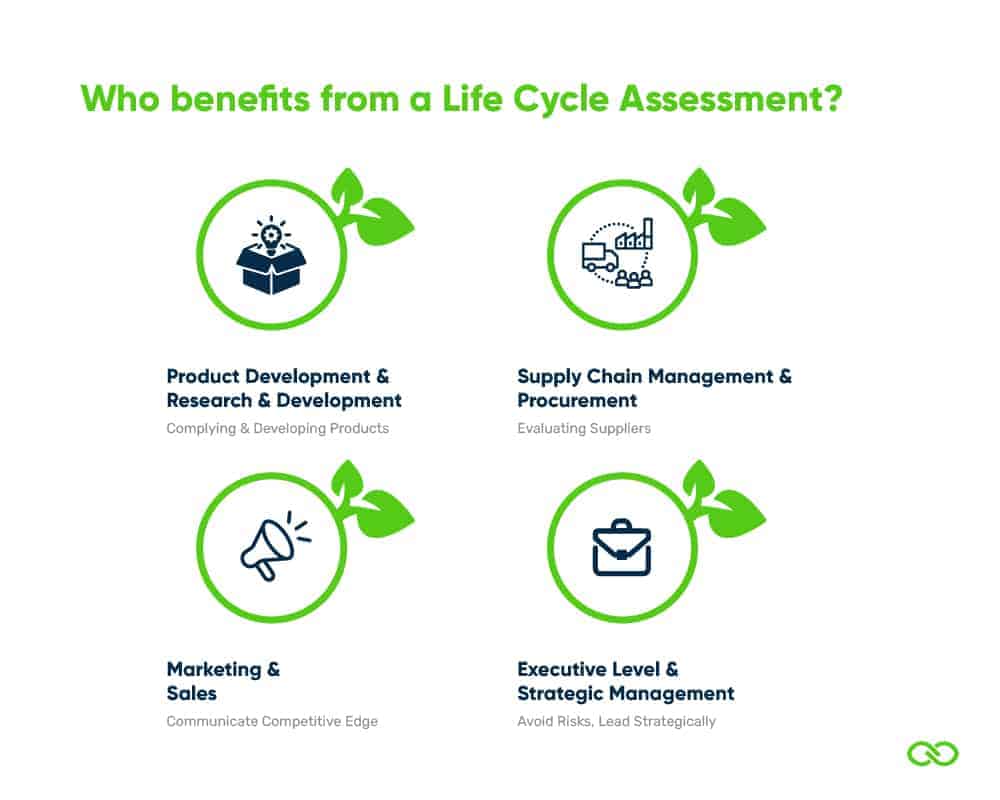
Product Management / Research & Development (R&D)
There are two reasons why a Life Cycle Assessment can be interesting for product management.
Reason 1: Comply With Regulations
Often, companies need to simply comply with regulations to continue doing business.
In some countries, there are standardized tenders for public projects. These tenders require companies to disclose the environmental data of their products – and you would have to conduct a Life Cycle Assessment for that.
A company that provides asphalt for a public road-building project might, for example, needs to provide the environmental footprint of that product to take part in that tender. To comply with these regulations, or optimizing existing products so they comply in the future, can be important for the product department.
Reason 2: New Product Development
New products should be as low in emissions as possible. This can be for many reasons – corporate policy, regulations, customer demand – but oftentimes, it simply means being more efficient with company resources.
One use case for an LCA might be that R&D compares two different materials and how these different materials influence the environmental impact of the end product.
Supply Chain Management / Procurement
In many industries, the supply chain accounts for more than 80 % of the environmental impact.
That means that sourcing from different suppliers can have a massive impact on your product footprint.
For Supply Chain Managers, choosing the right supplier is often a hard decision, where far more factors than just price play a role. A Life Cycle Assessment can give anyone working in Supply Chain Management or Procurement actionable insights into which company they should source from.
Marketing & Sales
Today, more than 81 % of consumers feel that companies should help improve the environment.
For marketing and sales, this means understanding how sustainable your products are – and how to communicate this to your customers.
A Life Cycle Assessment is the most vital step on that journey. Based on the generated insights, you can see where you already have an edge over your competitors – and where your company can use opportunities to become more sustainable.
Executive Level & Strategic Management
Chief Sustainability Officers are still a relatively new position. But more and more companies u understand sustainability isn’t a topic to be solved with simple greenwashing.
To make strategic decisions on how a company can have a more positive impact on the environment, buy-in from the highest level is important. This is why every LCA should transport actionable insights to the top management level.
An LCA looks at products from a broader point of view and analyses more than just carbon impact. That’s why it usually creates insights that another analysis might lose out on – an enormous chance for the entire company.
Recap: Who is an LCA interesting for?
Product Management / Research & Development:
1. Comply with regulations, 2. Develop new sustainable products
Supply Chain Management & Procurement
Find better suppliers
Marketing & Sales
Act on customer demand for sustainability
Executive Level & Strategic Management
Incorporate sustainability in the entire business
Sidenote: Sustainability often sounds like an abstract construct. In reality, being more sustainable can simply mean using less energy, recycling materials, or streamlining processes. All actions can save large amounts of money, immediately increase the bottom line, and make a company less dependent.
Before we dive into the process of an LCA, let us define what the product life cycle actually is.
2. The Product Life Cycle in LCA
If we want to assess the life cycle of a product, we have to first define what that lifecycle actually consists of.
5 Steps of a product life cycle: From Cradle To Grave
We will talk about different concepts of the product life cycle in just a moment, but generally, the product life cycle consists of five phases:
The 5 Steps of a Product Life Cycle (Cradle to Grave)
- Raw Material Extraction
- Manufacturing & Processing
- Transportation
- Usage & Retail
- Waste Disposal
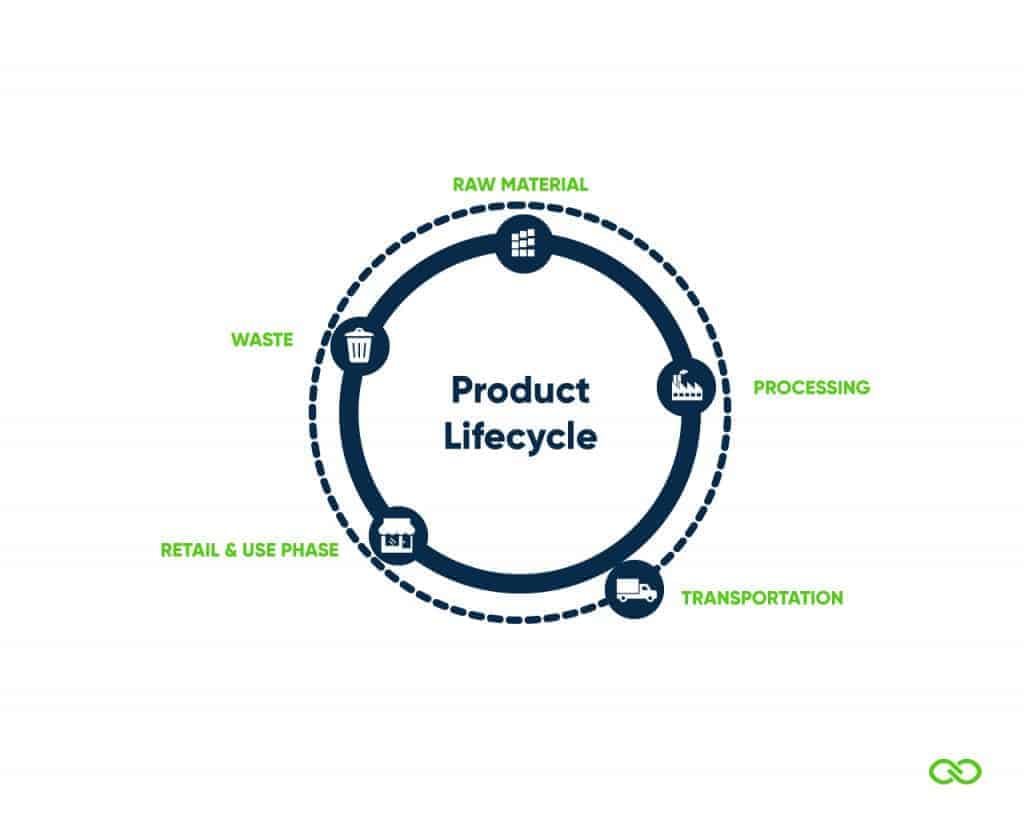
Different Life cycle models
Based on the stages you’re interested in or have data available on, you can choose to leave in or take out phases. There are usually 4 product life cycle models you can choose for your LCA.
Cradle-to-grave
When you analyze a product’s impact along the 5 product lifecycle steps – this is called cradle-to-grave. Cradle being the inception of the product with the sourcing of the raw materials, grave being the disposal of the product. Transportation is mentioned as step 3, but can, in reality, occur in between all steps.
Cradle-to-gate
Cradle-to-gate only assesses a product until it leaves the factory gates before it is transported to the consumer.
This means cutting out the use and disposal phase. Cradle-to-gate analysis can significantly reduce the complexity of an LCA and thus create insights faster, especially about internal processes. Cradle-to-gate assessments are often used for environmental product declarations (EPD).
Environmental Product Declarations (EPD)
Environmental Product Declarations are standardized certifications of a life cycle assessment, used mostly to verify impact data from business to business.
Cradle-to-cradle
Cradle-to-cradle is a concept often referred to within the Circular Economy. It is a variation of cradle-to-grave, exchanging the waste stage with a recycling process that makes it reusable for another product, essentially “closing the loop”. This is why it is also referred to as closed-loop recycling.
Gate-to-gate
Gate-to-gate is sometimes used in product life cycles with many value-adding processes in the middle.
To reduce complexity in the assessment, only one value-added process in the production chain is assessed. These assessments can later be linked together to complete a larger level Life Cycle Assessment.
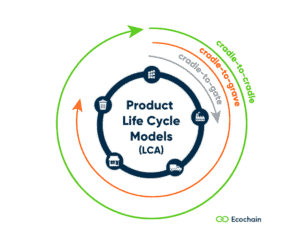
Life Cycle Models in LCA – Ecochain
There are three other LCA concepts that are used for special requirements.
Well-To-Wheel
Well-to-wheel is used for the Life Cycle Assessment of transport fuels and vehicles. Because there are a lot of steps in between – the “Well-to-tank” and “Tank-to-wheels”, this approach is more precise in calculating and assigning greenhouse gas emissions and energy usage for the different stages.
Economic Input-Output Life Cycle Assessment
The EIOLCA aggregates industry data with the goal to create impact data for specific sectors within the economy. These averages are sometimes used when no exact data is available. They don’t provide an exact picture of the impact but help to fill blanks. However, an EIOLCA is not precise enough to make decisions on a product level.
Environmental Impact Assessment
Environmental Impact Assessment is an analysis that is often conducted in the public sector, to look at the potential impact of a new construction project.
3. The 4 Phases of a Life Cycle Assessment
Now that we understand the differences between LCA models, we dive deeper into the actual phases of an LCA. The phases of a Life Cycle Assessment are defined in the ISO standards 14040 and 14044.
A Life Cycle Assessment Consists Of 4 Phases:
- Definition of Goal and Scope
- Inventory Analysis
- Impact Assessment
- Interpretation
But as you can see in the graphic below, the different steps depend on each other.
Moreover, the interpretation of the LCA doesn’t always have to depend on the actual assessment being completely finished.
Especially when a Life Cycle Assessment becomes more complex, continuously interpreting the results helps optimize the analysis as it goes further down the process.
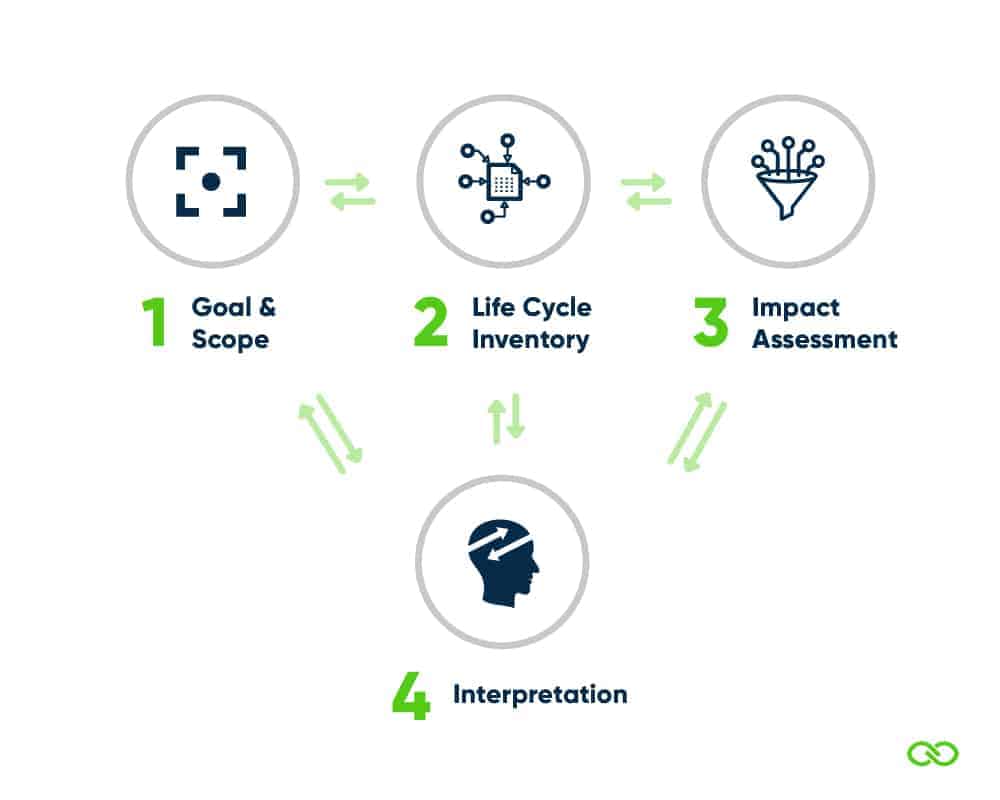
Phase 1: Definition of Goal and Scope
In the first phase of our Life Cycle Assessment, we define what exactly we want to analyze – and how deep we want to go with our analysis.
Defining our goal and scope serves three very important functions:
1. What will we be assessing?
Will it be a product? If so, how much of the product will we be assessing (functional unit)?
2. What system will we be assessing in?
This defines our product life cycle, as well as the implications we will be analyzing. Also, we have to decide which Impact Categories we want to focus our assessment on.
We might, for example, want to generate an Environmental Product Declaration for one of our products. If that is the goal, we have to build our assessment around the methods required by the political bodies, for example, the ministry of construction.
3. What Will We Not Be Assessing?
The value chain can go very deep.
However, a certain depth might not be interesting for our analysis. We might, for example, decide, that we won’t analyze the details of the pre-forms of our raw materials in-depth. Also, the social implications of the unit we are assessing might not be completely relevant.
This is an extremely important step. Because an analysis can – in theory – never be fully finished. If we analyze a certain raw material, will we also examine the implications it has on the family of the worker who harvested it?
Recap: 1. Step of an LCA – Goal & Scope
Defining the goal & scope of an LCA means defining what we want to analyze, how we want to analyze it, and how far we want to go with our analysis.

Life Cycle Assessment Example: Goal & Scope
To show how an LCA can look in practice, we use the example of a simple T-Shirt. A T-Shirt by itself is a relatively simple product. However, you still need to take a number of things into account to create a proper Life Cycle Assessment. We modeled our T-Shirt LCA in Mobius, our own easy Product Footprint tool.
Summary of the goal and scope of the analysis of a T-Shirt:
- The goal is to make the T-Shirt more sustainable by reducing its emissions during the lifecycle. Another goal is to manufacture it more efficiently by streamlining processes.
- We will look at the T-Shirt as a whole, analyzing the environmental impact from cradle to grave. We will look at the CO₂ emissions caused by one T-Shirt.
In this video, we model a simple product LCA of a T-Shirt in Ecochain Mobius, our own easy product footprint tool.
Phase 2: Life Cycle Inventory (LCI)

The Life Cycle Inventory Analysis (LCI) looks at the environmental inputs and outputs of a product or service. It is essentially the data collection phase of our LCA.
Look at it as buckets:
In phase 1, we defined the buckets we want to put our data in, in phase 2 we fill the buckets.
The goal is to quantify the environmental inputs and outputs – this means we measure everything that flows in and out of the system we defined in phase 1.
What could these inputs and outputs be?
– Raw materials or resources
– Different types of energy
– Water
– Emissions to air, land, or water by substance
This analysis can be extremely complex. Because production processes and supply chains can be complex constructs.
That’s why the Life Cycle Inventory phase of the Life Cycle Assessment usually takes the most work and time in your LCA.
How is the data for the Life Cycle Inventory collected?
Life Cycle Assessments today are conducted by professionals who are extensively trained in the norms and standards that define how an LCA should look like. We look deeper into these standards later in this guide. However, with software solutions like our product footprint tools Mobius and Helix, everybody can perform an LCA.
A lot of the data for the LCA is already available – for example in your electricity or water bills. But of course, that’s not all the data we need.
Therefore, at Ecochain we collect data through data collection sheets at this stage. These sheets gather quantitative data on a company level, process- and product level. If we need qualitative data, we use questionnaires. The data sheets get filled out by the stakeholders in the company who have access to the data.
Sometimes, industry averages have to be used. This is called secondary data. You can read more about the different kinds of data in our blog (primary vs secondary data).
One method for that would be the Economic input-output life cycle assessment we described earlier, which can give us data to fill in some blanks. Other times, the averages could be aggregated data gathered by branch organizations, financial institutes, NGOs, or market research organizations.
Modeling the LCI: Inventory Flow Models
Collecting the input and output data within a list or table would quickly lead to confusion. Moreover, it would also lead to important contexts going missing.
That is why the Life Cycle Inventory is typically illustrated with a flow model (image below).
The flow model clearly shows the system and unit we are analyzing, and the inputs & outputs. The data within the model needs to be collected for all activities within the scope of our Life Cycle Assessment.
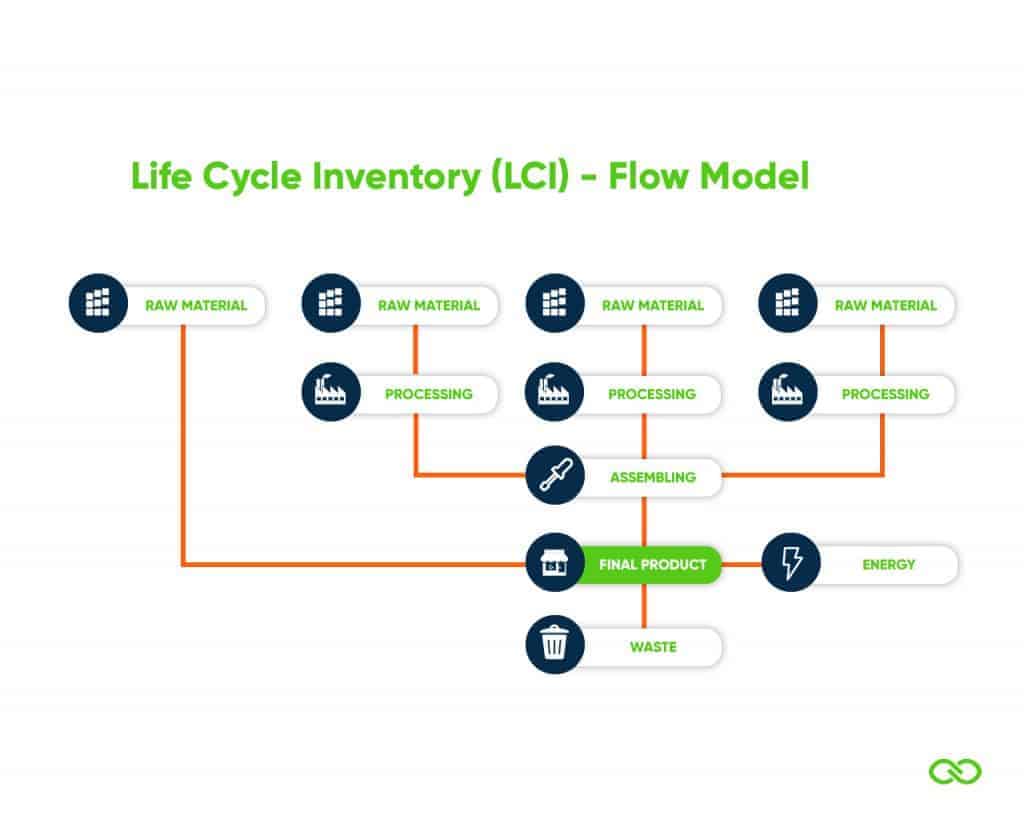
Life Cycle Assessment Example: Flow Model
A T-Shirt consists of fabric that is sewn together for the end product. The fabric itself also goes through different treatment processes. This is how the above flow model looks like in Mobius (you can access the full model for free by signing up for the 14-day free Mobius trial, our LCA software). Click to expand the picture!

And when we look at it in a structural tree diagram, this is what the life cycle inventory of a T-Shirt looks like.
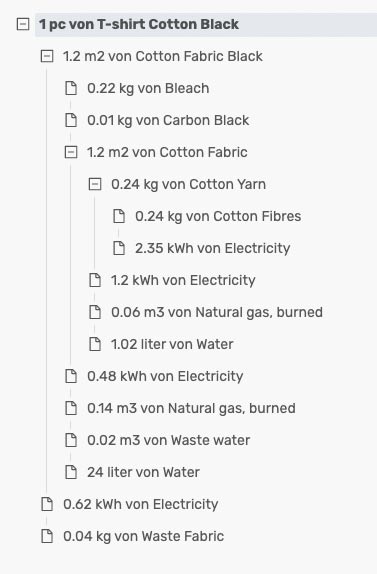
Recap: Phase 2 of an LCA: Life Cycle Inventory
The LCI is the data collection phase of a Life Cycle Assessment. We collect the data and model it into input-output flows.
Now that we have collected the data, it’s time to assign it in the next phase – the Life Cycle Impact Assessment (LCIA).
Phase 3: Life Cycle Impact Assessment

Until now, we defined what we want to measure and collect in phase 1. Then we collected and structured the data in phase 2.
In phase 3, we evaluate how significant the impacts are. This is based on our Life Cycle Inventory flows from phase 2.
There are 3 key tasks in this step.
Task 1: Selection of indicators and models
In phase 1 of our LCA, we defined our Impact Categories based on our goals. Impact Categories are what you want to measure your impact in. For example, you might want to measure the impact of your products on climate change in CO₂-equivalent.
Now, we define these impact categories more precisely.
There are many impact categories to choose from (15+). Depending on the goal and scope of your analysis, different categories might apply. The following are the most commonly used:
Common Impact Categories
- Human toxicity
- Global Warming Potential (carbon footprint)
- Ecotoxicity
- Acidification
- Eutrophication
Why are some impact categories measured in “equivalents”?
Some impact categories are measured in equivalents, often seen as a lowercase e or eq, for example, CO₂-e for CO₂-equivalent.
This is because several emissions contribute to the same impact category. For example, climate change or global warming potential (GWP) is measured in CO₂-equivalents. This doesn’t mean only CO₂ contributes to global warming, because, for example, also methane and nitrous oxide play a role there.
But to consolidate all gases into one indicator, all other gases are transposed into CO₂ equivalents.
Example
1kg CO₂ = 1kg CO₂-equivalent
1kg Methane (CH4) = 25kg CO₂-equivalent
1kg Nitrous oxide (N2O) = 298kg CO₂-equivalent
By assigning an equivalent, we can compare all these inputs to each other. Much like if you want to compare different currencies to each other.
However, the calculation of the equivalents doesn’t happen until step 3 in our impact assessment. First, we have to choose from the impact categories that are relevant to our overall assessment.
Task 2: Classification
In this step of our Life Cycle Impact Assessment, we are sorting our Life Cycle Inventory and assigning it to our defined impact categories.
Task 3: Impact Measurement
In the last step of our impact assessment, we finally calculate all our equivalents. We sum them up in overall impact category totals.
Category Totals can look like this:
- Environmental Cost Indicator (ECI) in EUR (or other currencies)
- Global Warming Potential (CO₂-equivalent in kg)
- Depletion potential of the stratospheric ozone layer (CFC-11-equivalent in kg)
- Acidification potential of land and water (SO2-equivalent in kg)
- Eutrophication potential (PO4-3-equivalent in kg)
- Formation potential of tropospheric ozone photochemical oxidants (ethene-equivalent in kg)
- Abiotic depletion potential for non-fossil resources (Sb-equivalent in kg)
- Human toxicity potential (1,4-DB-equivalent in kg)
- Freshwater aquatic ecotoxicity potential (1,4-DB-equivalent in kg)
- Marine aquatic ecotoxicity potential (1,4-DB-equivalent in kg)
- Terrestrial ecotoxicity potential (1,4-DB-equivalent in kg)
Life Cycle Assessment Example: LCI
Now that we know what we want to measure, what does the impact of the T-Shirt look like? Let’s look into our example in Ecochain Mobius again. In this example, we decided to measure the footprint of our T-Shirt in CO₂-equivalent, which is also called “Global Warming Potential”, short GWP. You can see that a lot of the impact of the T-Shirt comes from electricity.
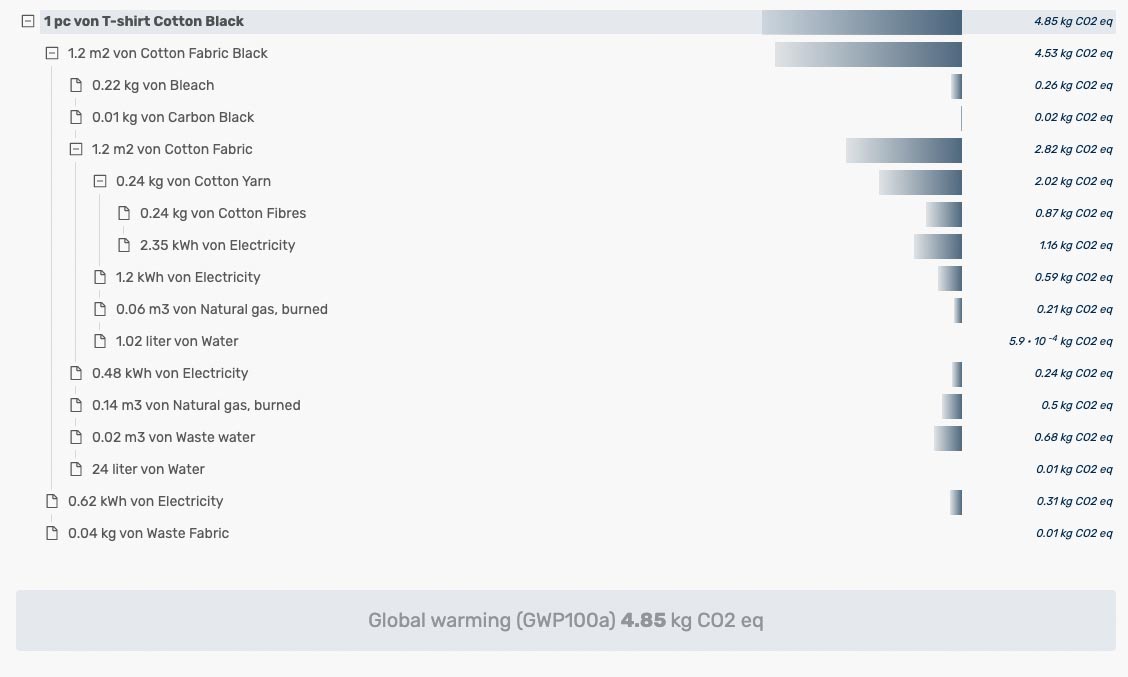
But how much actually comes from electricity? Mobius allows us to choose another view of our results. And in the flat view, our results are nicely summed up.
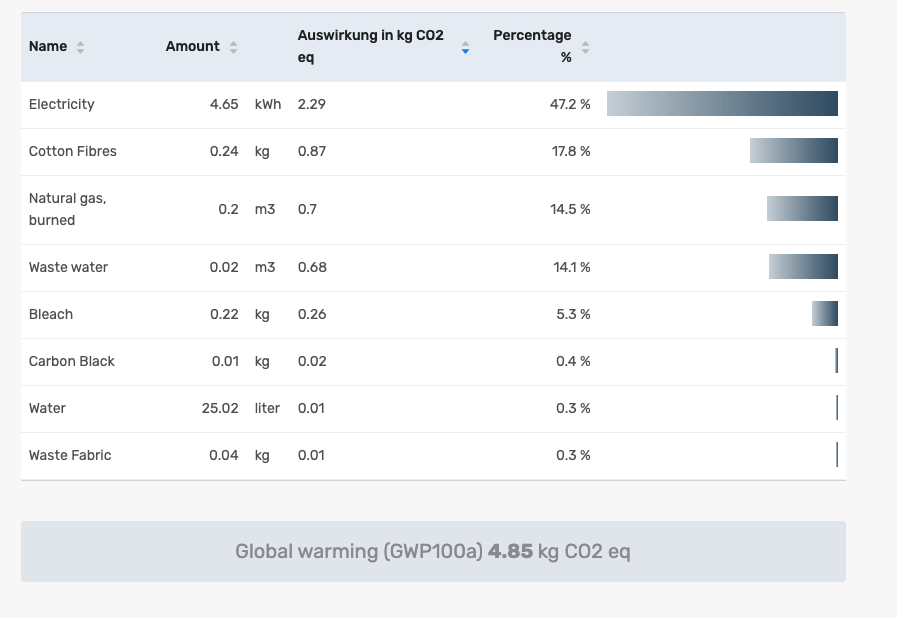
Now we see that almost 50% of the carbon footprint of our T-Shirt actually comes from the electricity we use to manufacture them. Only about 18% come from cotton fibers.
Now, let’s interpret our results.
Phase 4: Interpretation of our Life Cycle Assessment

As previously mentioned, we can always interpret our results during the assessment.
This means that the interpretation doesn’t necessarily have to happen at the very end.
But with all the data in place, we make the most reliable conclusions and recommendations.
This has to be done cautiously – just because three is lower than four, doesn’t mean that it is automatically the better alternative. Our results have to be put in context to analyze the overall picture.
What we want to interpret is also defined in the ISO norms defining the Life Cycle Assessment.
According to ISO 14044:2006, this is what the interpretation of a Life Cycle Assessment should include:
- Identifying significant issues based on our LCI and LCIA phase
- Evaluating the study itself, how complete it is, if it’s done sensitively and consistently
- Conclusions, limitations, and recommendations
So, what does that mean exactly?
It means that we have to make sure we collected accurate data and took care of measuring and analyzing it correctly. Only then we can make recommendations – otherwise, we would literally be “jumping to conclusions”!
Which conclusions can we draw from our assessment?
This is the juicy part of our assessment.
We started the entire task by defining our goals upfront.
Now, after we gained a lot of insights into our product or service, we can draw conclusions from it, such as:
- How high are the emissions of the product or service?
- How does it compare to other products in our portfolio?
- What are the biggest leverages to reduce the impact of our product?
- Can we be more efficient in manufacturing it?
Life Cycle Assessment Example: Interpretation
Remember our T-Shirt example?
Ecochain Mobius showed us that the biggest impact, almost 50%, comes from the electricity used in production. Based on this, we can now make better decisions. We could, for example, try to reduce the amount of electricity needed in production – or switch to a source of green energy. This is potentially much easier than, for example, exchanging the cotton we’re using.
In Mobius, you can see many more examples of the Life Cycle Assessment of a T-Shirt. We have pre-modeled T-Shirts with different materials and colors for you to take a look at! Try Mobius for free.
Now we should have a pretty deep understanding of what an LCA does, why we conduct it – and how.
In the next chapter, we look at the legal and technical standards that define how a Life Cycle Assessment should be conducted.
4. LCA Standards and the legal situation – a quick overview
ISO and other standards are absolutely necessary.
However, zooming in on them can be technical and time-consuming. To make our guide complete, we will just quickly explain what the individual ISO norms define.
ISO 14000: Environmental Management Standards
The ISO 14000 Environmental Management Standards are a family of standards. They define how companies and organizations manage their environmental responsibilities.
The following standards belong, as the numbers indicate, to this family. LCA software and any Environmental Management Software should comply with these standards, as does our own Environmental Intelligence Platform.
- ISO 14001: Environmental Management System: ISO 14001 defines the criteria Environmental Management Systems have to comply with. It ensures that environmental impacts are being measured and improved.
- ISO 14021: Environmental Claims and Labels: ISO 14021 defines how specific environmental claims have to be and how they have to be formulated and documented.
- ISO 14040:2006: Life Cycle Assessment Framework: ISO 14040:2006 defined the principles and framework of a Life Cycle Assessment. Many parts of this article are based on ISO 14040:2006.
- ISO 14044: The Update: ISO 14044 replaced earlier versions of ISO 14041 to ISO 14043.
- ISO 14067: Quantifying carbon footprint: ISO 14067 defines how the carbon footprint of products is quantified during a Life Cycle Assessment.
- ISO 50001: Efficient Energy Management: ISO 50001 defines Energy Management Systems.
EN 15804: European standard for Environmental Product Declarations (EPD) in the construction industry
EN 15804 defines the setup of Environmental Product Declarations in the construction industry.
PAS 2050 & GHG Protocol – Carbon Footprinting
PAS 2050 and the GHG Protocol are standards to define and measure emissions.
Life Cycle Accounting and Reporting Standard
This standard defines how the Life Cycle can be accounted for and reported on.
GRI data framework environment
The Global Reporting Initiative provides a framework to assess the environmental impact of companies and their supply chain.
European Energy Efficiency Directive (EED)
The European Energy Efficiency Directive is “a set of binding measures to help the EU reach its 20% energy efficiency target by 2020. Under the Directive, all EU countries are required to use energy more efficiently at all stages of the energy chain, from production to final consumption.”
PEF (Product Environmental Footprint) and OEF (Organisation Environmental Footprint)
PEF and OEF are currently under development. With PEF and OEF, the European Commission aims to harmonize methodology for the calculation of the environmental footprint of products and organizations. The system has been under development for several years now, and will in the end provide a standardized impact assessment method, a database with background LCA data and calculation rules for different industrial sectors (PEFCRs).
5. LCA: Criticism
We established how environmental management in general and Life Cycle Assessments, in particular, get standardized.
However, there are some points of concern on the concept of LCA worth mentioning.
System Thinking and limited boundaries
LCAs look for improvements in existing products. On a bigger scale, these improvements are often only small. For example, one company might choose a more sustainable raw material for one product – when in reality the supply chain of a completely different product makes the biggest impact.
This is why we created our bulk footprint tool Ecochain Helix. Helix applies our unique Activity-based footprinting approach to create a footprint for complete manufacturing sites and make LCAs of all your products at the same time. This enables companies to find hotspots in their environmental impact on a company & product level – and reduce them more efficiently. Also, it is much more dynamic than a traditional LCA – when one aspect in the chain changes, all the data gets dynamically updated.
Averages and samples instead of actual data
Oftentimes, LCAs rely on industry averages (called secondary data) due to a lack of actual raw data (primary data). This gets criticized as being inaccurate. Read more about this concern here.
Social implications missing
An LCA does not incorporate Social implications. However, social aspects are often interconnected with the environmental aspects of sustainability. This is not accounted for in an LCA. However, social LCA is currently under development.
6. Life Cycle Assessment (LCA) Software & Tools
LCA’s can be very technical and long calculations. And of course, tools and software solutions can make this easier.
However, we believe LCA tools are still not as accessible to businesses as they SHOULD be. That’s why we created our own two product footprint tools: Helix & Mobius.
Ecochain Helix: 100s of LCAs. In one go.
Ecochain Helix is our efficient bulk footprint tool. Instead of calculating a single LCA at a time, Ecochain Helix enables manufacturing companies to calculate LCAs of their complete product portfolio and (multiple) manufacturing sites – in one go. Based on input- and output flows of your company.
Request a free Helix demo here.
Ecochain Mobius: Measure & Design more sustainable products.
Ecochain Mobius is our easy product footprint tool. It allows you to measure your product’s footprint – in just 15 minutes. Mobius fits best if you want to embrace sustainable Product Design in your company. Get access to the world’s biggest environmental impact database for information on any material, ingredient, or component. Test alternative materials & designs and benchmark your product to industry standards.
Quick, Easy, Credible. Try it yourself – Start your 14-day free Mobius trial now.
Start with LCA yourself. Today.
Thank you for reading our complete Beginners Guide to Life Cycle Assessments. We hope you now have a deeper understanding of how LCA works and how it can help you.
Ecochain helps companies turn their environmental data into business opportunities. Our LCA software enables businesses to measure, understand, and claim the environmental footprint of their products. Efficiently & accessible.
Start with LCA today! Read more about our solutions.


